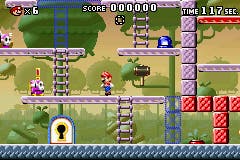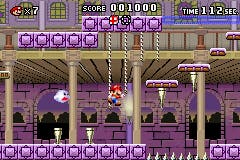Mario vs. Donkey Kong
We're puzzled. In a good way.
Does anybody know the Japanese for "Or, you know, we could just make a new 2D Mario platformer"? Nope, neither do we. And we're guessing the folks who commission Nintendo's handheld projects don't either. Having seemingly exhausted their back catalogue of traditional 8- and 16-bit Mario games for the loved/hated Mario Advance series, this shadowy cabal of commissioners now appear to have set their sights on another classic formula - that of the arcade Donkey Kong.
But, a bit of credit to them and developer NST: Mario vs. Donkey Kong doesn't just take the easiest possible route and completely rehash what's come before it. And it would have been very easy to simply recycle DK's mid-90s Game Boy outing. For a start it shifts the tried and trusted puzzle-solving format - which sees Mario navigating increasingly complex, enclosed 2D side-scrolling areas by jumping between platforms, climbing ladders, hopping between ropes, swinging from horizontal bars and using switches to turn on and off the different coloured sections of wall barring his progress - into a rendered graphics engine. But it also features nearly 50 new puzzles, and more than manages to emulate its ancestor's compulsive attraction.
Mini adventure

It is all about the puzzling. Narratively it's Spot The Dog rather than Tolstoy - apparently something in DK's head has snapped and he's taken up his old hording, barrel-chucking ways by nabbing a shipment of Mini-Mario toys, and it's up to our portly moustachioed hero to intervene and retrieve them - and once you get past that there's really nothing to stand between you and your love affair with the admirable precision of both mechanics and level design. You have six worlds to conquer, each comprising six traditional puzzle locations (split into two halves), a Lemmings-style stage that involves shepherding the boggle-eyed Mini-Marios back into a toy box, and a showdown with DK that, as ever, involves lobbing things at him a few times.
The idea is old and simple, but Mario soon has lots of abilities to avail himself of, and their introduction is handled well via some pre-level tutorial videos that quickly and intuitively graft the skill du jour onto your existing repertoire. At first he jumps lightly around, grabs objects ala Super Mario Bros. 2 by standing on them and pressing B, and flicks switches to bring chunks of coloured blocks into and out of play; the challenge being to get the key in one area to the door in another without having to put it down for more than a few seconds. But before long he's also swinging up from bars to platforms and hanging ropes, moving between the ropes themselves, clobbering enemies with the hammer power-up, performing double and triple-jumps, shimmying along high wires, and so on.
None of it feels forced upon you, and the gradual introduction of new elements means that you'll take to the puzzling very quickly and can happily keep track of all the different means you can apply to a particular situation. Nobody should have trouble playing this game after more than a few minutes in its company - and anybody with a past history of playing classic DK titles will feel right at home despite the relatively glitzy graphics, wider variety of moves, and the jabbery story sequences, which serve more to keep tireless Yahoo-er Charles Martinet in steady work than anything else.
Beyond the kong

It's not long before you're attuned to plotting routes in your head as you approach each area, picking your way through the gates of logic lain at your feet with a meticulous and rarely derailed commitment that, regrettably, will probably see you dispatch the game's total of stages in just a few short hours. Even though each puzzle stage is split into two parts - one to collect the key and get to the door, the other simply to get your hands on the resident Mini-Mario DK seemingly dropped in his haste to depart - they will all still fall fairly quickly to a determined player, and only the bloody-minded difficulty levels of some of the DK boss encounters will put up a sustained resistance.
Fortunately there's much for completists to busy themselves with. Each stage is also littered with a few throwaway gifts that you can also collect, and you can maximise your score and rating for each stage by grabbing these and completing your goals in the shortest time possible. Boss stages meanwhile up your score and rating depending on how few hits you manage to take from DK's arsenal of falling blocks and other obstacles. Get the most out of the game's regular challenges and you'll be rewarded with a much tougher challenge in the Hard and Expert series of stages.
The result of all this is a game that treads a well worn path with some style, and there's not much to say against it. When it grates, it's only because you know what you're meant to do and in your haste you've managed to foul it up by jumping into a spike pit or landing face to face with an enemy instead of safely on its back. Hardly capital.
Good monkey business
It won't come as anything new or inspiring to anybody who's tackled a DK title before, but it engages the brain in ways that we enjoy being probed, and for all its age the formula is still as sound as ever. Meanwhile, it's a new thrill for a younger generation of handheld owners, and has the potential to be a fantastic stocking filler for anybody who likes to haul out the console on a train or bus to school. It's not the most imaginative, it won't last forever, and we're not particularly sold on the pre-rendered visual approach (give us something from Yoshi's Island any day), but it's hard to argue with any game where every level feels like slotting in the last piece of a jigsaw puzzle.

